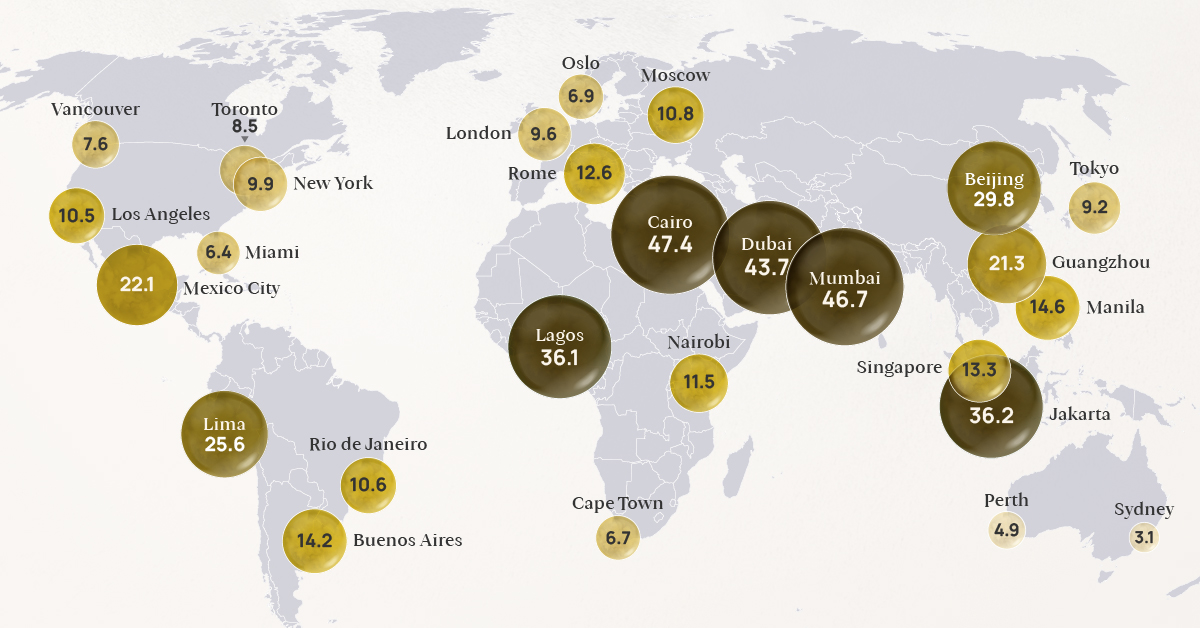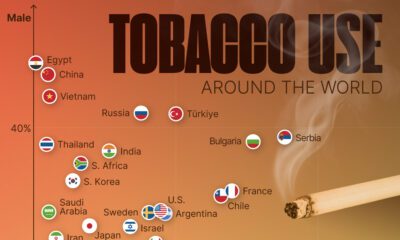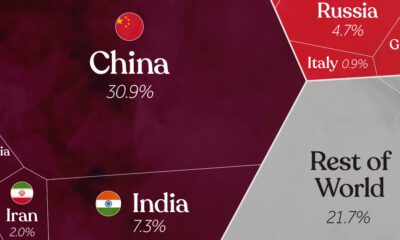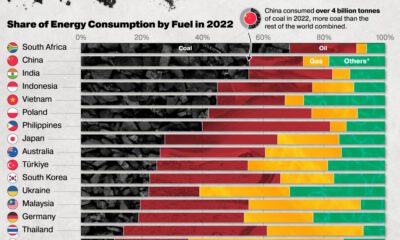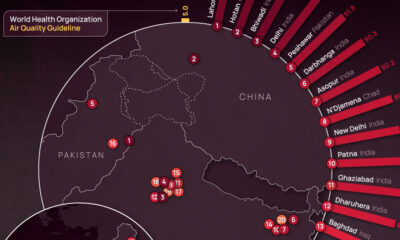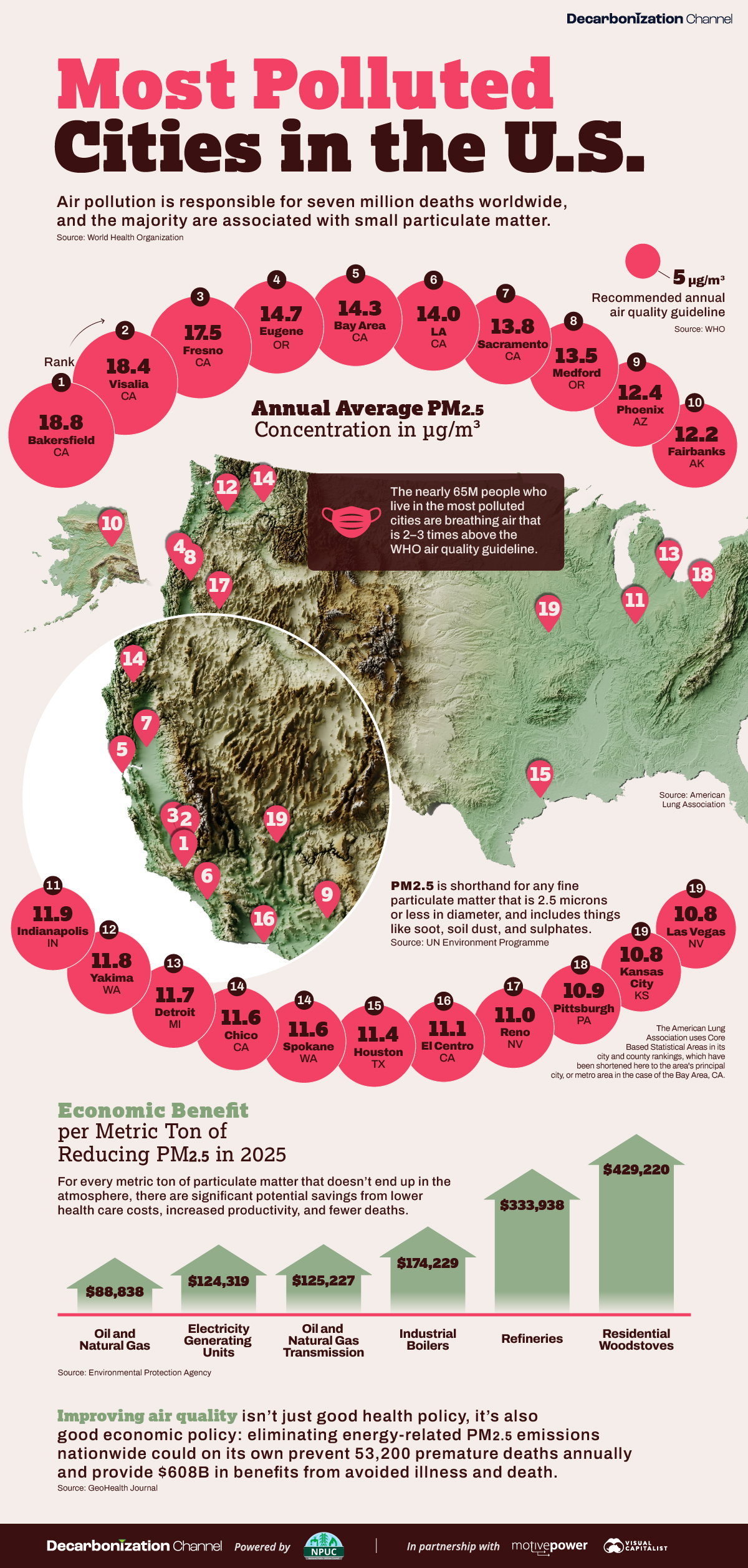Green
Mapped: Air Pollution Levels Around the World in 2022
![]() Subscribe to the Elements free mailing list for more like this
Subscribe to the Elements free mailing list for more like this
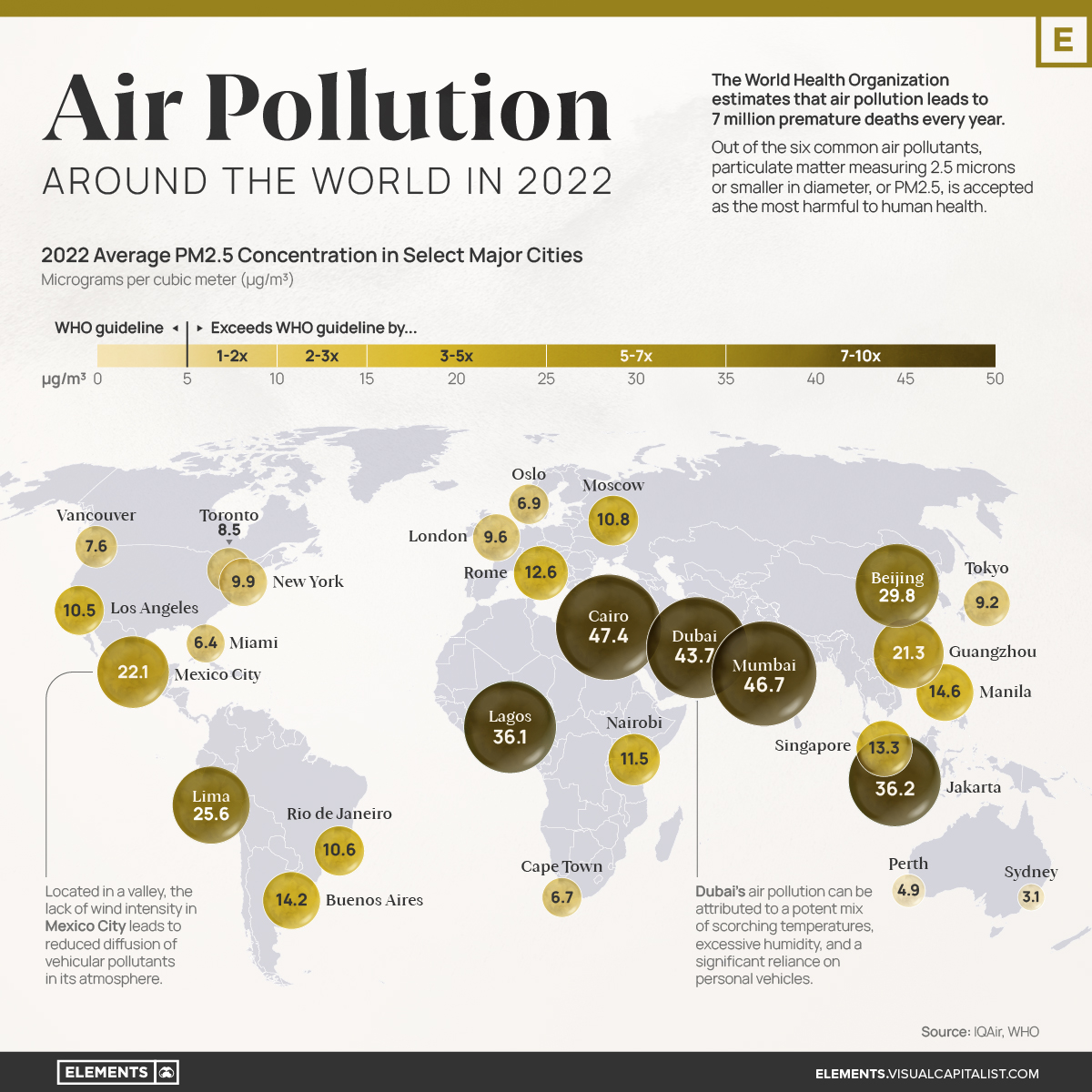
Mapped: Air Pollution Levels Around the World
This was originally posted on Elements. Sign up to the free mailing list to get beautiful visualizations on natural resource megatrends in your email every week.
The World Health Organization (WHO) estimates that air pollution leads to 7 million premature deaths every year.
Out of the six common air pollutants, particulate matter measuring 2.5 microns or smaller in diameter, or PM2.5, is accepted as the most harmful to human health. This is due to its prevalence in the atmosphere and the broad range of adverse health effects associated with its exposure, such as heart disease, stroke, lung cancer and chronic respiratory diseases.
With that context in mind, this visualization uses IQAir’s World Air Quality Report to map out the 2022 average PM2.5 concentrations in select major cities around the globe, expressed in micrograms per cubic meter (μg/m³).
Understanding the WHO Air Pollution Guidelines
Did you know that in 2019, only 1% of the global population lived in places where WHO global air quality guidelines were met?
Designed to protect public health from the harmful effects of air pollution, the guidelines cover a range of air pollutants, including particulate matter, ozone, nitrogen dioxide, sulfur dioxide, and carbon monoxide.
The healthy limits for PM2.5 are set at an annual average of 0-5 μg/m³.
| WHO Classification | Annual Average PM2.5 Concentration (μg/m³) | % of countries within classification, 2022* |
|---|---|---|
| WHO Air Quality Guideline | 0 - 5 | 9.9% |
| Interim Target 4 | 5.1 - 10 | 18.3% |
| Interim Target 3 | 10.1 - 15 | 19.8% |
| Interim Target 2 | 15.1 - 25 | 28.2% |
| Interim Target 1 | 25.1 - 35 | 9.9% |
| Exceeds Target Levels | 35.1 - 50 | 7.6% |
| Exceeds Target Levels | > 50 | 6.1% |
*Percentages are calculated as a proportion of the 131 countries that had sufficient air quality data and were included in IQAir’s World Air Quality Report in 2022.
According to IQAir’s World Air Quality Report, only 13 countries or territories met the recommended concentration of PM2.5 in 2022. Among them were Australia, Finland, Puerto Rico, Iceland, Bermuda, and Guam.
Above this guideline, many countries fell within the four interim targets, while nearly 14% recorded air pollution levels that exceeded all target levels.
The Effects of Air Quality on Mortality
While it can be a little difficult to grasp what the above concentrations represent, thinking of them in terms of their effect on mortality can shed some light on their significance.
According to the WHO, non-accidental mortality rates multiply by 1.08 per 10 µg/m³ increase in PM2.5 concentration, but only up to 35 μg/m³. Above that, mortality growth rates may not be linear, resulting in many more deaths.
Here is an example to highlight what that means.
- Say that, for a population living within the WHO PM2.5 guideline, the non-accidental mortality rate is arbitrarily set to 100 deaths for a given period.
- If this area’s PM2.5 concentration goes up to 10 μg/m³, putting them at Interim Target 4, they would see 104 deaths in that same amount of time.
- At Interim Target 3, where their PM2.5 concentration would be 15 μg/m³, they would see 108 deaths.
- At Interim Target 2, they’d see 117.
- Finally, at Interim Target 1, they’d see 126.
Beyond Interim Target 1 (above 35 μg/m³), deaths would potentially grow much faster. As of 2022, around 14% of countries report levels above this threshold, including Chad, India, Pakistan, Qatar, and Nigeria.
The State of Air Pollution Around the World
While many cities in North America and Europe have seen steady and relatively lower PM2.5 concentrations during the last few years, many cities (especially those in Asia) have been making strides in lowering their air pollution levels.
Nonetheless, many of them still record PM2.5 concentrations that are more than six times the WHO guideline.
| City | 2022 annual average PM2.5 concentration (μg/m³) | 2018 annual average PM2.5 concentration (μg/m³) |
|---|---|---|
| 🇪🇬 Cairo, Egypt | 47.4 | N/A |
| 🇮🇳 Mumbai, India | 46.7 | 58.6 |
| 🇦🇪 Dubai, UAE | 43.7 | 55.3 |
| 🇮🇩 Jakarta, Indonesia | 36.2 | 45.3 |
| 🇳🇬 Lagos, Nigeria | 36.1 | N/A |
| 🇨🇳 Beijing, China | 29.8 | 50.9 |
| 🇵🇪 Lima, Peru | 25.6 | 28 |
| 🇲🇽 Mexico City, Mexico | 22.1 | 19.7 |
| 🇨🇳 Guangzhou, China | 21.3 | 33.2 |
| 🇵🇭 Manila, Philippines | 14.6 | N/A |
| 🇦🇷 Buenos Aires, Argentina | 14.2 | 12.4 |
| 🇸🇬 Singapore, Singapore | 13.3 | 14.8 |
| 🇮🇹 Rome, Italy | 12.6 | N/A |
| 🇰🇪 Nairobi, Kenya | 11.5 | N/A |
| 🇷🇺 Moscow, Russia | 10.8 | 10.1 |
| 🇧🇷 Rio de Janeiro, Brazil | 10.6 | N/A |
| 🇺🇸 Los Angeles, USA | 10.5 | 14.4 |
| 🇺🇸 New York, USA | 9.9 | N/A |
| 🇬🇧 London, UK | 9.6 | 12 |
| 🇯🇵 Tokyo, Japan | 9.2 | 13.1 |
| 🇨🇦 Toronto, Canada | 8.5 | 7.8 |
| 🇨🇦 Vancouver, Canada | 7.6 | N/A |
| 🇳🇴 Oslo, Norway | 6.9 | 8.2 |
| 🇿🇦 Cape Town, South Africa | 6.7 | N/A |
| 🇺🇸 Miami, USA | 6.4 | 7.8 |
| 🇦🇺 Perth, Australia | 4.9 | N/A |
| 🇦🇺 Sydney, Australia | 3.1 | 7.6 |
Most parts of the world did not meet the annual WHO recommendation for clean and healthy air in 2022.
However, the cost of inaction toward cleaner air is very high. In addition to the millions of premature deaths each year, the global cost of health damages associated with air pollution currently sits at $8.1 trillion.
Unfortunately, things that are integral to our quality of life, such as industrial activities, transportation, energy production, and agricultural practices, are also the leading causes of air pollution around the world.
As such, a multi-faceted approach to lowering pollution is essential to protect lives, especially to benefit those already more vulnerable to poor air quality, such as kids and the elderly.
Environment
The Most Polluted Cities in the U.S.
What are the most polluted cities in the U.S. according to data from the American Lung Association’s 2024 State of the Air Report?
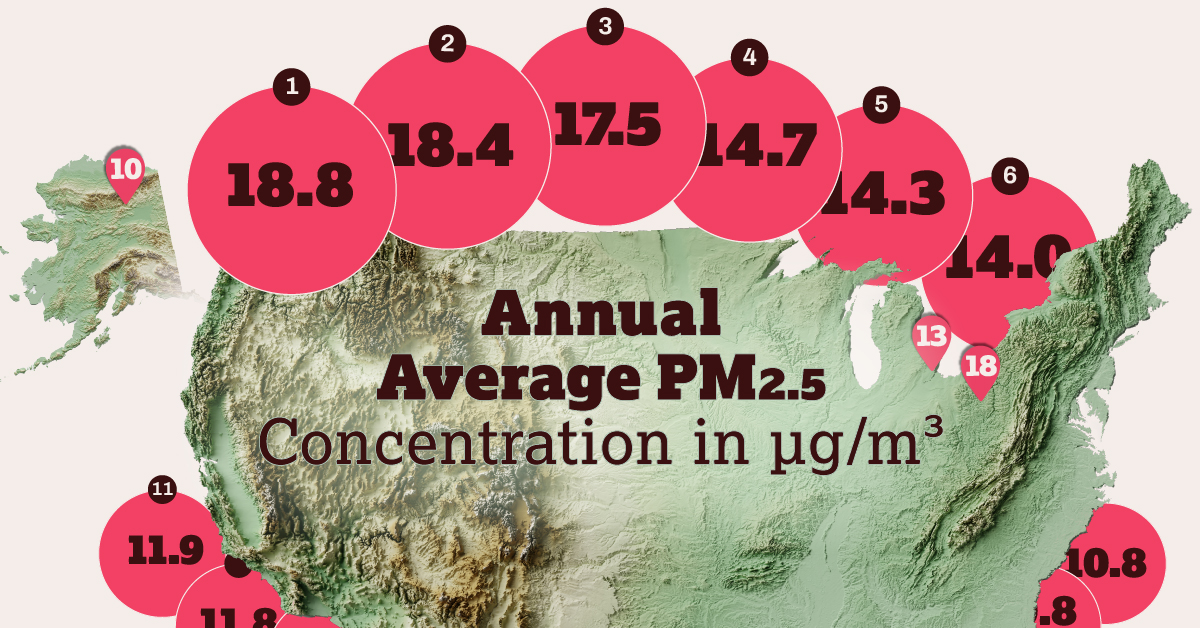
The Most Polluted U.S. Cities in 2024
According to the World Health Organization, air pollution is responsible for 7 million deaths annually, and could cost the global economy between $18–25 trillion by 2060 in annual welfare costs, or roughly 4–6% of world GDP.
And with predictions that 7 in 10 people will make their homes in urban centers by mid-century, cities are fast becoming one of the frontlines in the global effort to clear the air.
In this visualization, we use 2024 data from the State of the Air report from the American Lung Association to show the most polluted cities in the United States.
What is Air Pollution?
Air pollution is a complex mixture of gases, particles, and liquid droplets and can have a variety of sources, including wildfires and cookstoves in rural areas, and road dust and diesel exhaust in cities.
There are a few kinds of air pollution that are especially bad for human health, including ozone and carbon monoxide, but here we’re concerned with fine particulate matter that is smaller than 2.5 microns, or PM2.5 for short.
The reason for the focus is because at that small size, particulate matter can penetrate the bloodstream and cause all manner of havoc, including cardiovascular disease, lung cancer, and chronic pulmonary disease.
The American Lung Association has set an annual average guideline of 9 µg/m³ for PM2.5, however, the World Health Organization has set a much more stringent limit of 5 µg/m³.
The 21 Worst Polluted Cities in the U.S.
Here are the top 21 most polluted cities in the U.S., according to their annual average PM2.5 concentrations:
| Rank | City, State | Annual average concentration, 2020-2022 (µg/m3) |
|---|---|---|
| 1 | Bakersfield, CA | 18.8 |
| 2 | Visalia, CA | 18.4 |
| 3 | Fresno, CA | 17.5 |
| 4 | Eugene, OR | 14.7 |
| 5 | Bay Area, CA | 14.3 |
| 6 | Los Angeles, CA | 14.0 |
| 7 | Sacramento, CA | 13.8 |
| 8 | Medford, OR | 13.5 |
| 9 | Phoenix, AZ | 12.4 |
| 10 | Fairbanks, AK | 12.2 |
| 11 | Indianapolis, IN | 11.9 |
| 12 | Yakima, WA | 11.8 |
| 13 | Detroit, MI | 11.7 |
| T14 | Chico, CA | 11.6 |
| T14 | Spokane, WA | 11.6 |
| 15 | Houston, TX | 11.4 |
| 16 | El Centro, CA | 11.1 |
| 17 | Reno, NV | 11.0 |
| 18 | Pittsburgh, PA | 10.9 |
| T19 | Kansas City, KS | 10.8 |
| T19 | Las Vegas, NV | 10.8 |
Note: The American Lung Association uses Core Based Statistical Areas in its city and county rankings, which have been shortened here to the area’s principal city, or metro area in the case of the Bay Area, CA.
Six of the top seven cities are in California, and four in the state’s Central Valley, a 450-mile flat valley that runs parallel to the Pacific coast, and bordered by the Coast and Sierra Nevada mountain ranges. As a result, when pollution from the big population centers on the coast is carried inland by the wind—cities #5 and #6 on the list—it tends to get trapped in the valley.
Bakersfield (#1), Visalia (#2), and Fresno (#3) are located at the drier and hotter southern end of the valley, which is worse for air quality. The top three local sources of PM2.5 emissions in 2023 were farms (20%), forest management / agricultural waste burning (20%), and road dust (14%).
Benefit to Economy
While the health impacts are generally well understood, less well known are the economic impacts.
Low air quality negatively affects worker productivity, increases absenteeism, and adds both direct and indirect health care costs. But the flip side of that equation is that improving air quality has measurable impacts to the wider economy. The EPA published a study that calculated the economic benefits of each metric ton of particulate matter that didn’t end up in the atmosphere, broken down by sector.
| Sector | Benefits per metric ton |
|---|---|
| Residential Woodstoves | $429,220 |
| Refineries | $333,938 |
| Industrial Boilers | $174,229 |
| Oil and Natural Gas Transmission | $125,227 |
| Electricity Generating Units | $124,319 |
| Oil and Natural Gas | $88,838 |
At the same time, the EPA recently updated a cost-benefit analysis of the Clean Air Act, the main piece of federal legislation governing air quality, and found that between 1990 and 2020 it cost the economy roughly $65 billion, but also provided $2 trillion in benefits.
Benefit to Business
But that’s at the macroeconomic level, so what about for individual businesses?
For one, employees like to breathe clean air and will choose to work somewhere else, given a choice. A 2022 Deloitte case study revealed that nearly 70% of highly-skilled workers said air quality was a significant factor in choosing which city to live and work in.
At the same time, air quality can impact employer-sponsored health care premiums, by reducing the overall health of the risk pool. And since insurance premiums averaged $7,590 per year in 2022 for a single employee, and rose to $21,931 for a family, that can add up fast.
Consumers are also putting their purchase decisions through a green lens, while ESG, triple-bottom-line, and impact investing are putting the environment front and center for many investors.
And if the carrot isn’t enough for some businesses, there is the stick. The EPA recently gave vehicle engine manufacturer Cummins nearly two billion reasons to help improve air quality, in a settlement the agency is calling “the largest civil penalty in the history of the Clean Air Act and the second largest environmental penalty ever.”

Learn how the National Public Utilities Council is working toward the future of sustainable electricity.

-

 Environment1 month ago
Environment1 month agoRanked: Top Countries by Total Forest Loss Since 2001
The country with the most forest loss since 2001 lost as much forest cover as the next four countries combined.
-

 Environment3 months ago
Environment3 months agoCharted: Share of World Forests by Country
We visualize which countries have the biggest share of world forests by area—and while country size plays a factor, so too, does the environment.
-
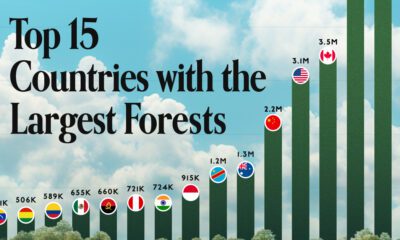
 Environment4 months ago
Environment4 months agoWhich Countries Have the Largest Forests?
Together, the top five countries with the largest forests account for more than half of the world’s entire forest cover.
-
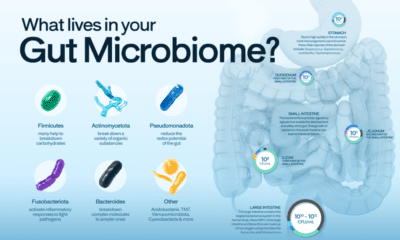
 Environment5 months ago
Environment5 months agoVisualized: What Lives in Your Gut Microbiome?
The human gut microbiome contains a world of microbes. We look at the the bacteria that deeply affect our health and well-being.
-

 Environment5 months ago
Environment5 months agoMapped: Global Temperature Rise by Country (2022-2100P)
In this set of three maps, we show the global temperature rise on a national level for 2022, 2050, and 2100 based on an analysis by…
-
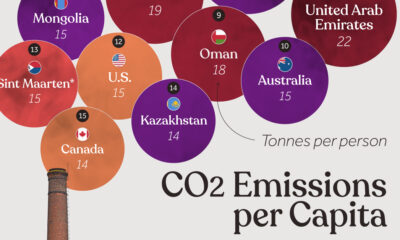
 Environment5 months ago
Environment5 months agoRanked: Per Capita Carbon Emissions by Country
Which countries rank the highest in per capita carbon emissions, and how do they impact the world’s total carbon emissions?
-

 Technology1 week ago
Technology1 week agoCountries With the Highest Rates of Crypto Ownership
-

 Mining6 days ago
Mining6 days agoVisualizing Copper Production by Country in 2023
-

 Politics7 days ago
Politics7 days agoCharted: How Americans Feel About Federal Government Agencies
-

 Healthcare1 week ago
Healthcare1 week agoWhich Countries Have the Highest Infant Mortality Rates?
-

 Demographics1 week ago
Demographics1 week agoMapped: U.S. Immigrants by Region
-

 Economy1 week ago
Economy1 week agoMapped: Southeast Asia’s GDP Per Capita, by Country
-

 Automotive1 week ago
Automotive1 week agoHow People Get Around in America, Europe, and Asia
-

 Personal Finance1 week ago
Personal Finance1 week agoVisualizing the Tax Burden of Every U.S. State

